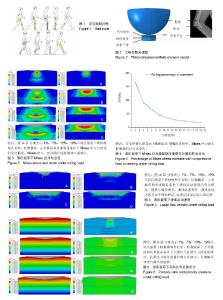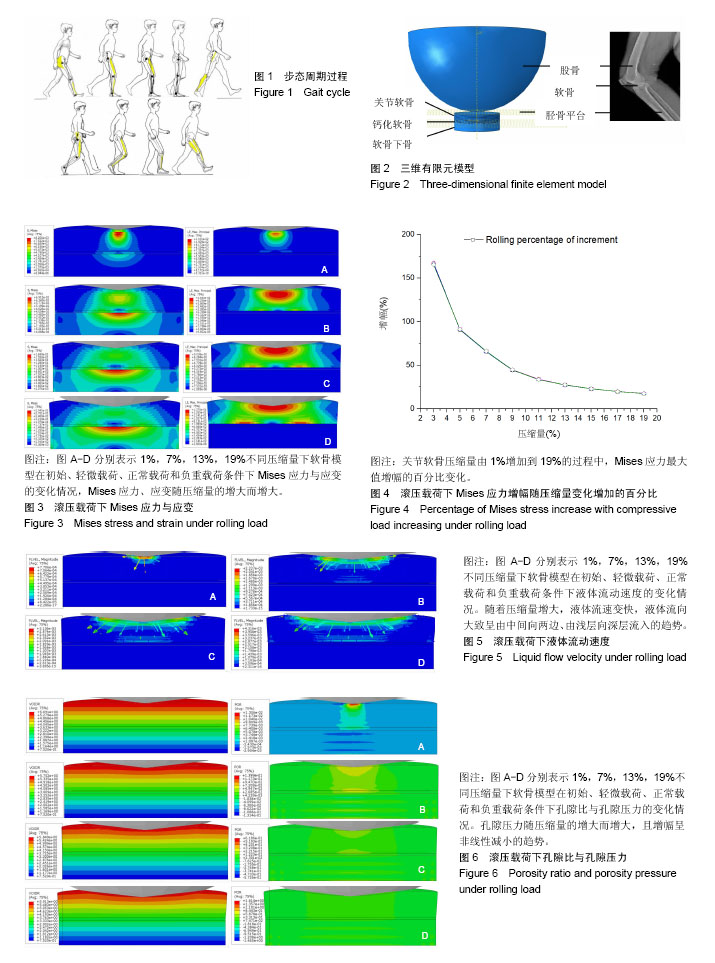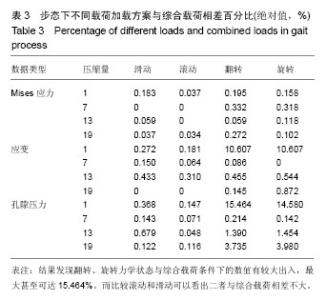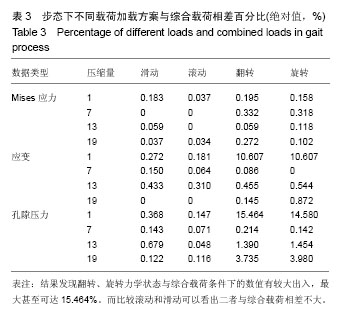| [1] Mow VC, Kuei SC, Lai WM, et al. Biphasic creep and stress relaxation of articular cartilage in compression? Theory and experiments. J Biomech Eng. 1980;102(1):73-84. [2] Mow V. Structure and function of articular cartilage and meniscus. Basic Orthopaedic Biomechanics.2005.[3] Guo H, Shah M, Spilker R L. A finite element implementation for biphasic contact of hydrated porous media under finite deformation and sliding. Proc Inst Mech Eng H. 2014;228(3): 225-236.[4] Wang X, Ayati BP, Brouillete MJ, et al. Modeling and simulation of the effects of cyclic loading on articular cartilage lesion formation. Int J Numer Method Biomed Eng. 2014; 30(10):927-941.[5] Gao LL, Zhang CQ, Yang YB, et al. Depth-dependent strain fields of articular cartilage under rolling load by the optimized digital image correlation technique. Mater Sci Eng C Mater Biol Appl. 2013;33(4):2317-2322.[6] Gao LL, Zhang CQ, Dong LM, et al. Description of depth-dependent nonlinear viscoelastic behavior for articular cartilage in unconfined compression. Materials Science and Engineering C.2012;32(2):119-125.[7] Zhang CQ, Gao LL, Dong LM, et al. Depth-dependent normal strain of articular cartilage under sliding load by the optimized digital image correlation technique. Materials Science and Engineering C.2012;32(8):2390-2395.[8] 卫小春. 关节软骨[M]. 北京: 科学出版社, 2007.[9] Meng Q, An S, Damion R A, et al. The effect of collagen fibril orientation on the biphasic mechanics of articular cartilage. J Mech Behav Biomed Mater. 2017;65:439-453.[10] Halonen KS, Mononen ME, Jurvelin JS, et al. Deformation of articular cartilage during static loading of a knee joint-experimental and finite element analysis. J Biomech. 2014;47(10):2467-2474.[11] Joseph A. Buckwalter, Thomas A. Einhorn, Sheldon R. Simon. Orthopaedic basic science:biology and biomechanics of the musculoskeletal system. Second edition. 2000. 陈启明,梁国穗,等译.骨科基础科学-骨关节肌肉系统生物学和生物力学[M].北京:人民卫生出版社, 2003:407-420.[12] 李哲,徐镭,倪国新.不同强度跑台运动对大鼠软骨下骨三维结构的影响[J].中华物理医学与康复杂志,2016,38(11):803-806.[13] Li LP, Buschmann MD, Shirazi-Adl A. A fibril reinforced nonhomogeneous poroelastic model for articular cartilage: inhomogeneous response in unconfined compression. J Biomech. 2000;33(12):1533-1541.[14] van der Voet A. A comparison of finite element codes for the solution of biphasic poroelastic problems. Proc Inst Mech Eng H, 1996; 210(2):209-211.[15] 孟迪. 压缩载荷下软骨缺损修复后力学状态的研究[D]. 天津:天津理工大学, 2016.[16] 张述卿. 软骨缺损修复的有限元模拟及滚压装置的设计[D]. 天津:天津理工大学, 2011.[17] 郜军霞. 培养物袋装滚动加载的生物反应器研制及有限元仿真[D]. 天津:天津理工大学, 2012.[18] Wilson W, van Donkelaar CC, Huyghe J M. A comparison between mechano-electrochemical and biphasic swelling theories for soft hydrated tissues.J Biomech Eng.2005; 127(1):158-165.[19] Dabiri Y, Li L P. Altered knee joint mechanics in simple compression associated with early cartilage degeneration. Comput Math Methods Med. 2013;2013:862903[20] Dabiri Y, Li L P. Influences of the depth-dependent material inhomogeneity of articular cartilage on the fluid pressurization in the human knee. Med Eng Phys. 2013;35(11):1591-1518.[21] Elhamian SM, Alizadeh M, Shokrieh MM, et al. A depth dependent transversely isotropic micromechanic model of articular cartilage. J Mater Sci Mater Med.2015; 26(2):111.[22] 刘清宇,王富友,刘俊利,等.含有天然钙化软骨层骨软骨支架的研制[J].中华创伤杂志,2014,30(5):467-470.[23] Madry H, Orth P, Cucchiarini M. Role of the subchondral bone in articular cartilage degeneration and repair. J Am Acad Orthop Surg. 2016;24(4):e45-6.[24] Yang T, Spilker RL. A Lagrange multiplier mixed finite element formulation for three-dimensional contact of biphasic tissues. J Biomech Eng. 2007;129(3):457-471.[25] Ateshian GA, Maas S, Weiss JA. Finite element algorithm for frictionless contact of porous permeable media under finite deformation and sliding.J Biomech Eng.2010; 132(6):061006.[26] 郝智秀,冷慧杰,曲传咏,等. 骨与膝关节生物力学行为研究[J]. 固体力学学报, 2010, 31(6):603-612. [27] 孙英彩,崔建岭,李石玲,等. MRI测量正常人膝关节软骨厚度[J]. 实用放射学杂志,2004,20(11):1007-1010.[28] 晏丹,周广东,曹谊林. 关节软骨生化结构及其与力学性能关系研究进展[J]. 上海交通大学学报(医学版),2009, 29(3):341-345.[29] Federico S, Grillo A, La Rosa G, et al. A transversely isotropic, transversely homogeneous microstructural-statistical model of articular cartilage. J Biomech. 2005;38(10):2008-2018.[30] 戴尅戎. 力学生物学在骨与软骨研究中的应用[J]. 中华骨科杂志,2006,26(6):429-431.[31] Guo H, Spilker RL. Biphasic finite element modeling of hydrated soft tissue contact using an augmented Lagrangian method.J Biomech Eng.2011;133(11):111001.[32] Madry H. The subchondral bone: a new frontier in articular cartilage repair. Knee Surg Sports Traumatol Arthrosc. 2010; 18(4):417-418.[33] Chung C, Burdick JA. Engineering cartilage tissue. Adv Drug Deliv Rev. 2008;60(2):243-262.[34] Guilak F. Functional tissue engineering. Annals of the New York Academy of Sciences.2002;961(1):193-195.[35] 戴尅戎. 骨与关节的力学生物学研究[C]// 全国生物力学学术会议,2009:1-1. |



